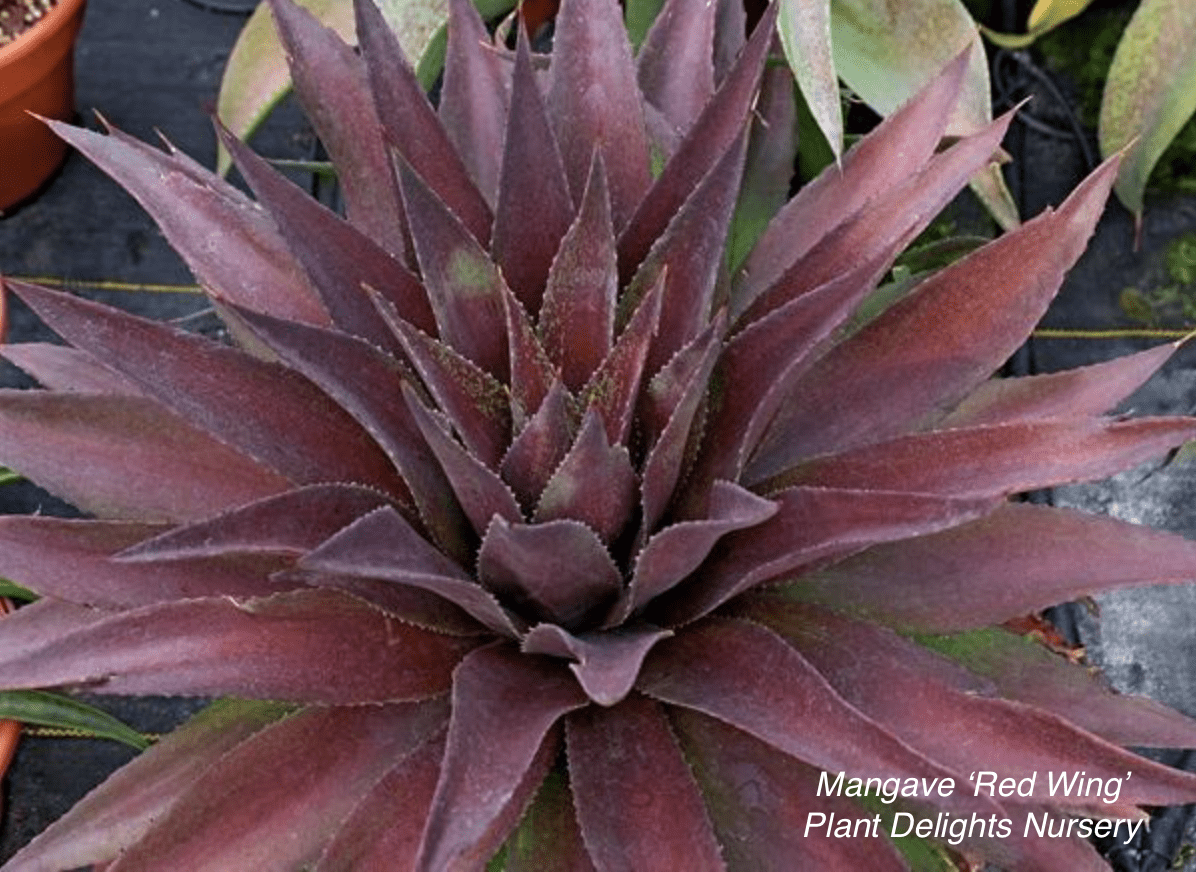
Plant Expert Tony Avent on Mangaves

Tony Avent, Plant Delights Nursery
According to plant expert Tony Avent, owner of Plant Delights Nursery in Raleigh, NC, “the world of mangaves is exploding. The colors and forms continue to break new barriers of previously inconceivable foliage.” Founded in 1988, Tony’s nursery is a premier source of rarities and natives, and offers more than 1,400 kinds of perennials via mail-order.
Plant Delights’ Spring ’19 catalog includes two dozen recently introduced Mangave cultivars. “The parade of amazing new mangaves hasn’t slowed,” Tony says. “Once people see and grow mangaves, they realize how fantastic they are.”
Here’s more from Tony Avent on these intriguing Manfreda–Agave crosses:
Breeding Mangave
“It started back in the ’90s on a visit to Yucca-Do Nursery in Texas. They’d collected seeds from a manfreda in Mexico, and two of the seedlings were five times as big as they should be. They had spots like manfreda but were enormous, and their structure was agave-like. The blooms were just not right. Agave celsii had been growing in the next valley, and we realized, OMG, we have a Mangave!
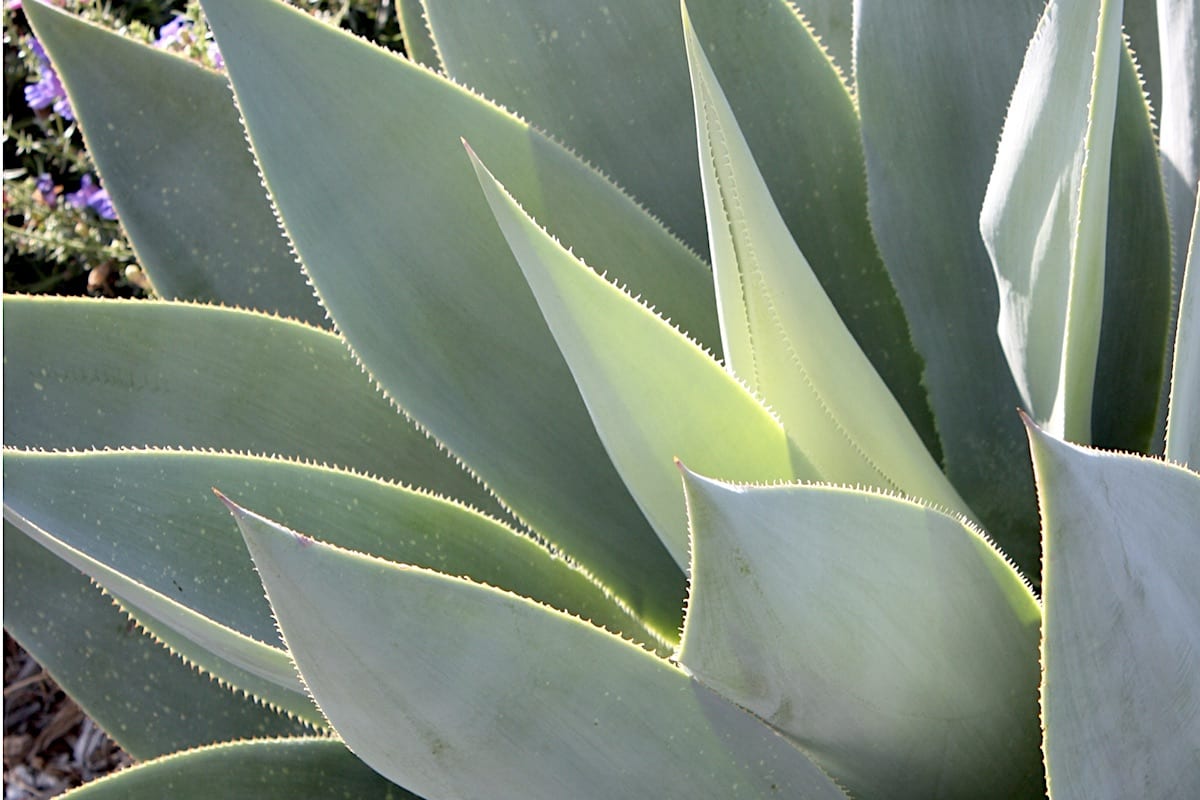
Agave celsii
“We started breeding them at Plant Delights, and after five years of crossing, we could see the potential. It’s like when Dan Heims got started with Heuchera.
We do a lot of trials, but taking on mangaves was just too much. We gave all our breeding stock to Hans Hansen, an incredible plantsman and hybridizer at Walters Gardens in Michigan. The mangaves sat unnoticed in the back of a greenhouse until the cover came off the building. When exposed to ultraviolet light, they turned all these incredible colors.
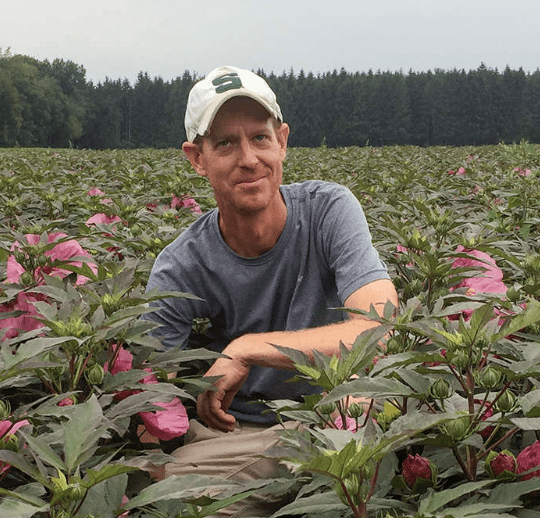
Hybridizer Hans Hansen is Director of Plant Development at Walters Gardens, Zeeland, MI.
“We send pollen off of every agave that flowers to Hans. What he’s done is create agaves with purple and red spots. They’re fast growers with hybrid vigor. A mangave plug grown from tissue culture takes 12 to 16 weeks to fill out a quart container, then another two weeks to fill a gallon. Agaves, in comparison, take 63 weeks. Hans grows a thousand seedlings, selects 100, then 50, then 25. Then he picks one or two to keep and sends us a few discards to trial. That way we have the advantage of knowing what the crosses will do.
“I’ve never felt the need to second-guess Hans. He’s very keen on what he’s created and understands what’s cool and how to use the plants—their garden value. It’s been challenging for him. He’s in Michigan breeding for the West Coast, but he realizes how good these plants are, and he’s persevered.
Mangave characteristics
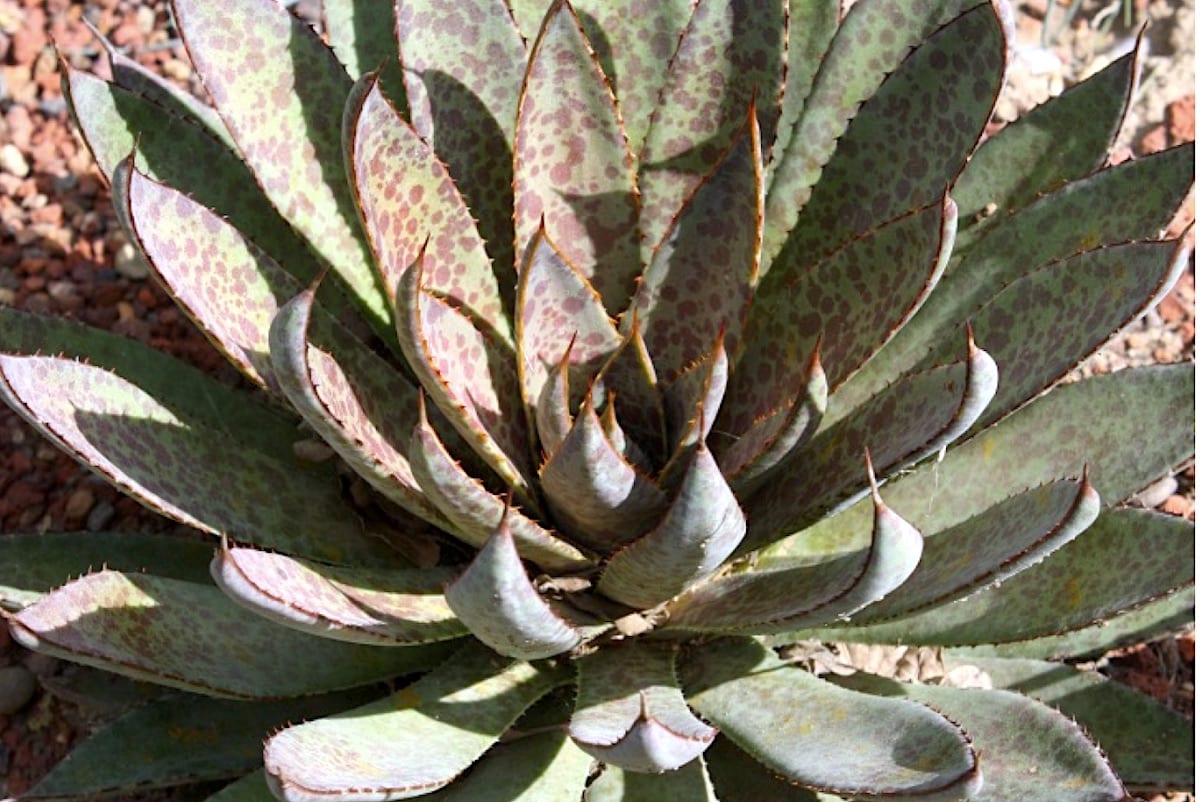
Mangave ‘Bloodspot’
“So far we haven’t seen any mangaves that are monocarpic like their agave parents. ‘Bloodspot’ flowered and produced 50 offsets. We’ve never lost a mangave to flowering. Manfredas, if it’s too cold—upper 30s, low 40s—become deciduous. They also may go summer-dormant where temperatures are high.
“Mangave roots tend to conform to the pot size, like agaves. They may be screaming, but they’ll stay small in a small container. Leaf fragility…some are more brittle than others. Early ones were incredibly brittle. The way we solve the breakage problem when shipping them is to let them dry down. Leaves that become flaccid don’t break.
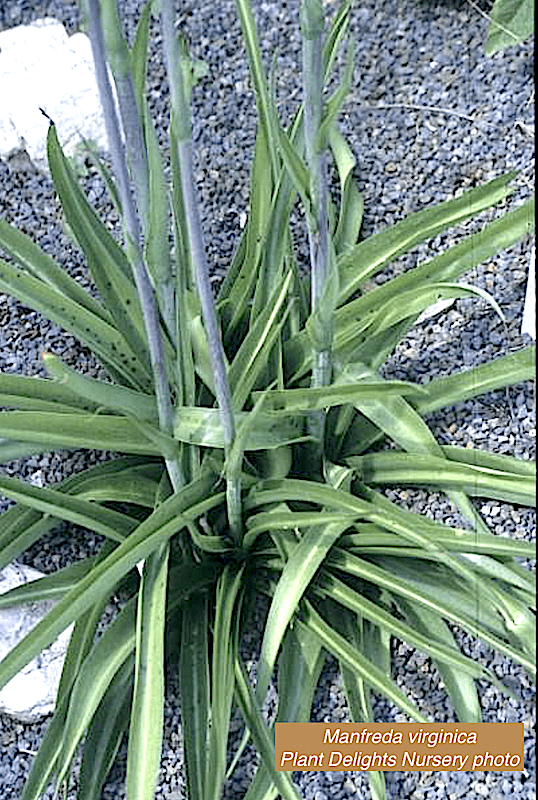
“Manfreda virginica is insanely hardy.” — Tony Avent
“Mangave cultivars are not necessarily winter hardy. It depends on their parentage. Manfredas are found in Zones 4 through 8, from the Midwest to southern Illinois, central North Carolina, Florida, central Texas and central Mexico. They’re dry-land plants, but are more tolerant of overwatering than agaves. Even in a hurricane, a mangave will keep on going. As for extreme drought, mangaves are probably not as tolerant as agaves, but again, it depends on the parent. You can’t say of any genus, ‘They’ll all do this.’
“Mangaves are fantastic in containers. They’re not great indoors—they lose their color without UV light. If need be, overwinter them inside, then take them outside in the spring.
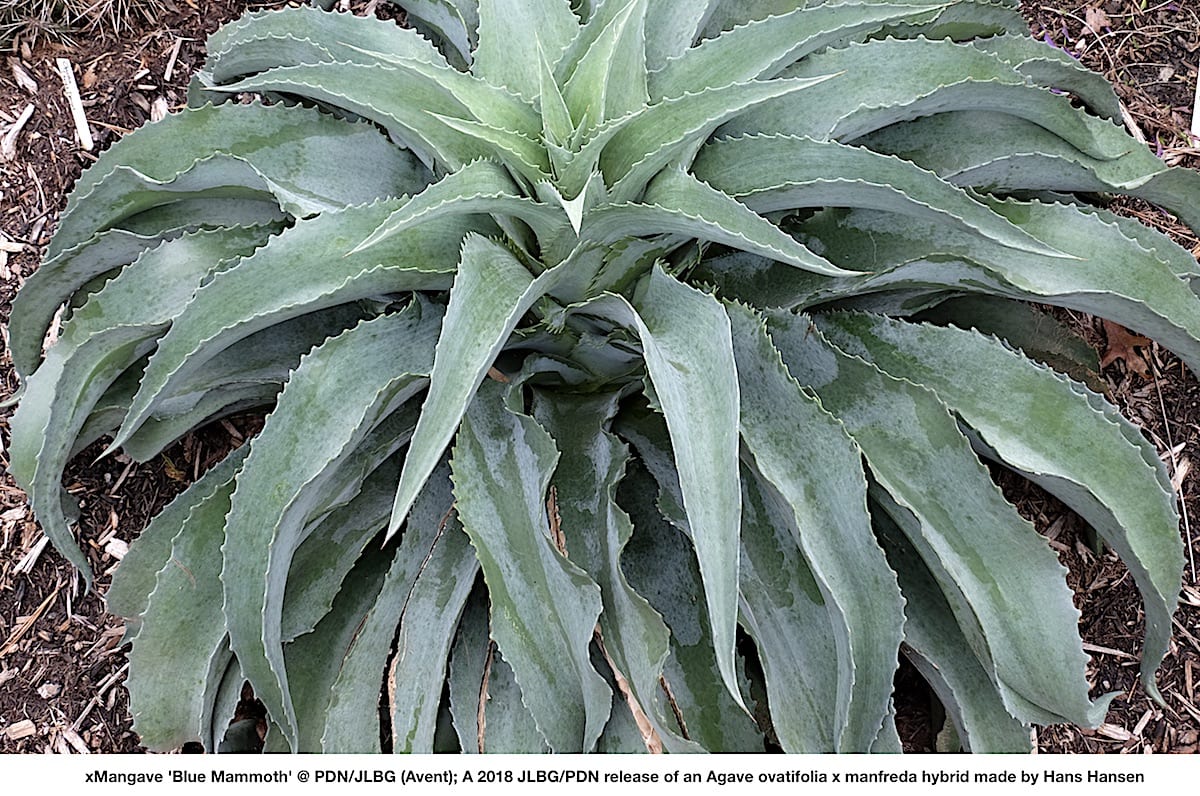
Mangave ‘Blue Mammoth’ is among the most hardy.
“Mangave ‘Blue Mammoth’ has been the most hardy in our trials, to 7 degrees Fahrenheit. It’s an Agave ovatifolia hybid that forms a 2-foot-tall by 4-feet-wide rosette of jagged blue leaves with olive spots. Other mangaves that go to Zone 7 are ‘Falling Waters’ and ‘Bad Hair Day’.
Another new genus: Hansara
“We offer Hansara ‘Jumping Jacks,’ the first tri-generic hybrid, which we named after Hans. Agave, Manfreda, Polyanthes and Hosta are all closely related. So Hans started making tri-generic crosses, aiming for highly fragrant flowers, Mexican color, and hardiness. Crosses of Hosta and Agave are the most difficult to make.
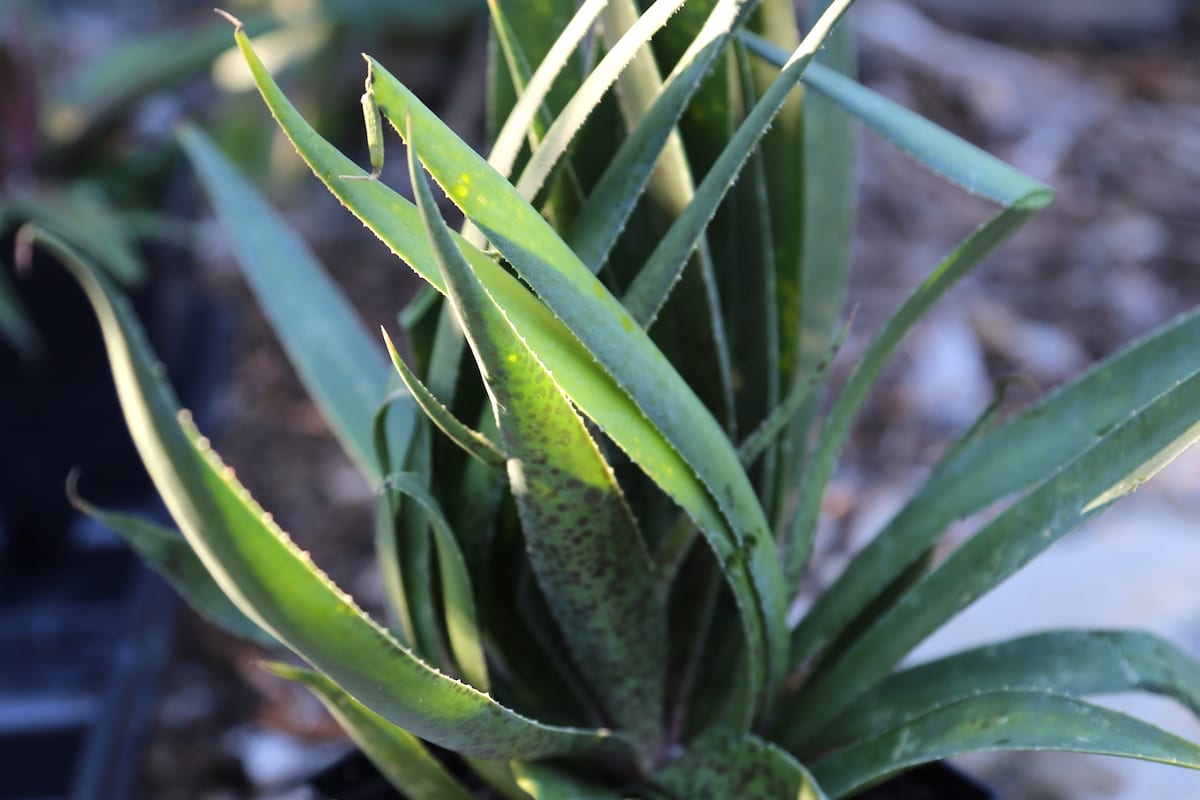
Hansara ‘Jumping Jacks’ combines the genes of Agave gypsophila ssp. pablocarrilloi, Agave macroacantha, Manfreda maculosa, Polyanthus tuberosa, and Polyanthus howardii.
“‘Jumping Jacks’ forms a 14-inch-tall by 27-inch wide clump of narrow, succulent, gray-green foliage, sparsely spotted purple. When mature in 2 to 3 years, it produces a 6 foot-tall, highly branched flower spike of lovely yellow flowers but with an insignificant fragrance.
Mangaves in the stratosphere
“Mangaves like ‘Red Wing’ (shown at top) have foliage colors that don’t look real. Variegated manfredas as parents will launch mangaves into the stratosphere. What’s been done so far is maybe 2 percent of what can and will be done. In California and Mediterranean climates this is an opportunity to rewrite what people do with their landscapes.
“Every day there’s something new and exciting with plant hybridization. It’s a great time to be alive.”
Learn more about mangaves…
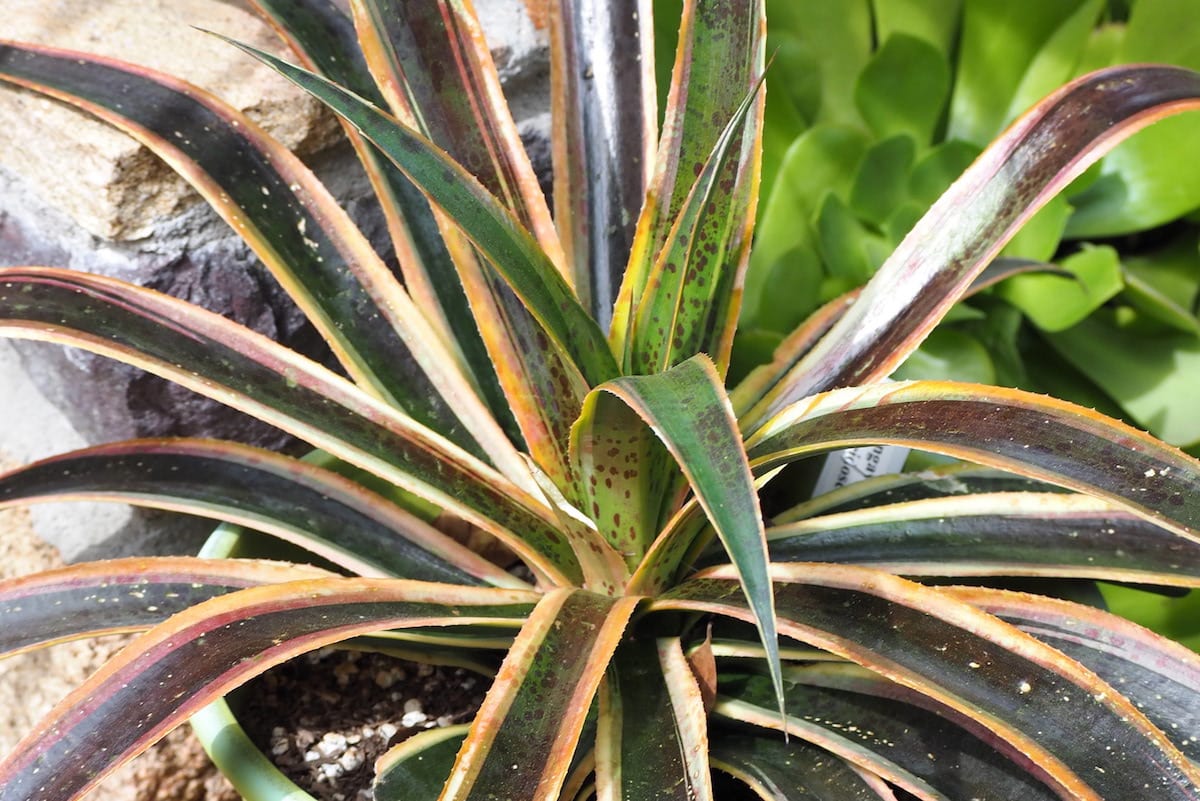
Above: Mangave ‘Kaleidoscope’ in my garden.
On my page, “Testing Mangaves in My Garden” you’ll learn about the Mangave cultivars I’m trialing in my Zone 9b Southern CA garden. This is a report on the first batch of 14 that arrived two years ago…[Continue reading]
See the mangave page on the Plant Delights Nursery website.
Connect with hybridizer Hans Hansen on his Facebook page: “Mad About Mangave”.
Where to find mangaves online:
Plant Delights Nursery
Mountain Crest Gardens
Watch my Mangave videos:
My Dozen Mangave Cultivars (5:38)
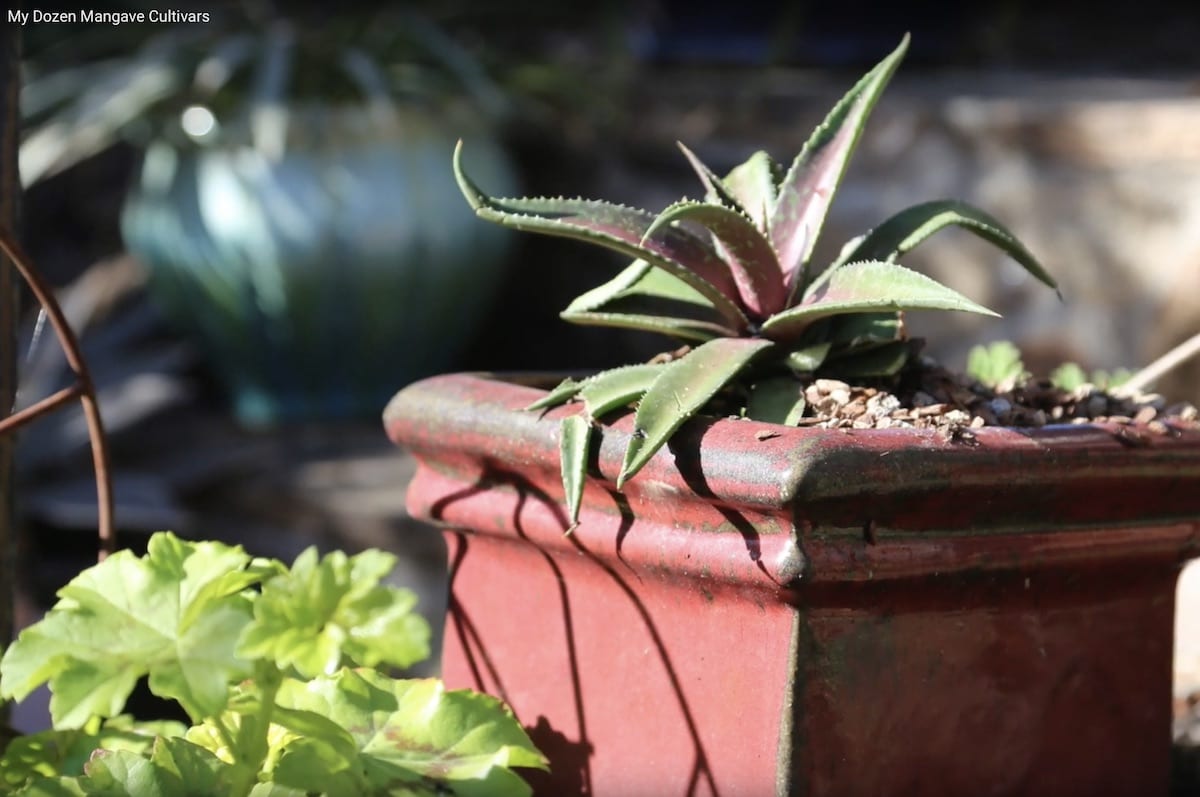
Come on a mangave treasure hunt with me as I track down a dozen cultivars that have been in the ground and in pots for two years. All have done well and some better than others. I evaluate the plants’ progress and how to attain their full beauty and potential.
Mangave Unboxing (8:44)
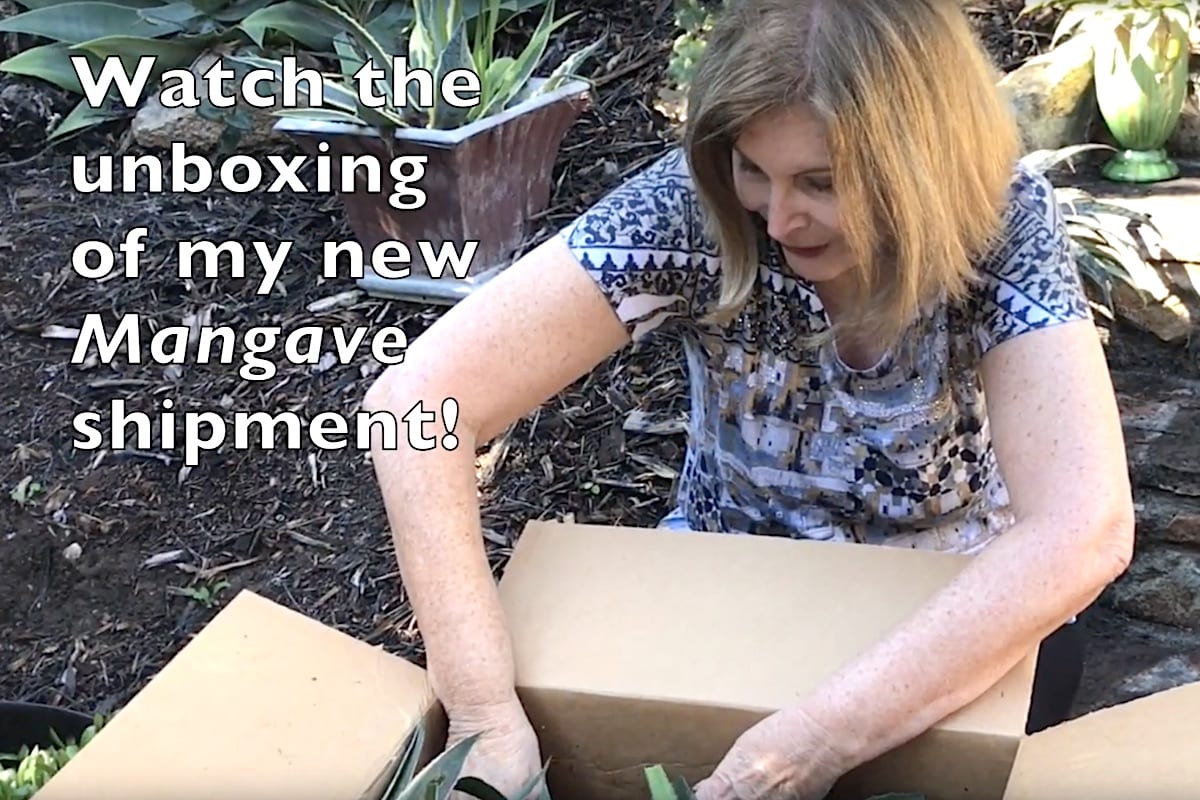
Come on a mangave treasure hunt with me as I track down a dozen cultivars that have been in the ground and in pots for two years. All have done well but some better than others. I evaluate their progress and consider how to help each attain its full beauty and potential.
Planting Mangaves (5:31)
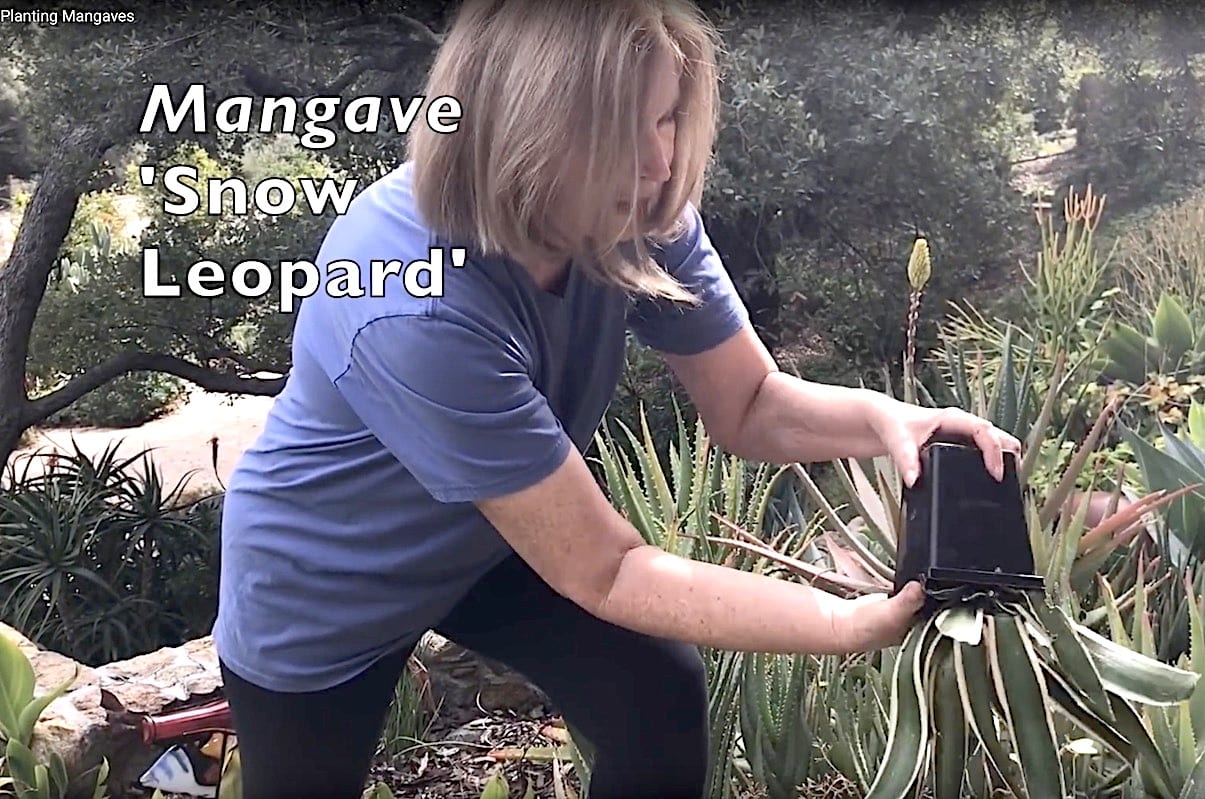
With 18 exciting new Mangave cultivars to find a place for in my garden, I design and plant my new “Mangave Terrace” and perform “C-sections” on potbound cultivars rarin’ to go.

Hi I have a propeller bloodspot and it had alot of spots when I got it,now its losing all its spots what am I doing wrong?it gets up to 110 in Los banos its outside in a planter and was beautiful now it grew alot of babies but spots at going away help please!
Hi Kim — I’m out of my depth on this one. I’ll forward your Q along to Tony.
Curious which Mangaves are offsetting?
Great question! It’s been my experience that when a mangave blooms, the main plant dies but lots of pups carry on. They cluster tightly around the mother plant, so can be tricky to divide. Breeder Hans Hansen has a Facebook Page where he answers questions, so I’ll post this there as well.
So wouldn’t that mean that they’re monocarpic? It says in the article that they are polycarpic but I have also found that the mother plant dies after blooming, so which is it?? Thanks
I grow over a dozen varieties. About a third have matured and flowered, and I have yet to lose one to blooming. I cut off the flower spikes at the base of the plant so they don’t drain it of energy (and there’s no point in keeping them; they’re not especially attractive, and I haven’t seen offsets form along the bloom spike). Typically the stalks die and offsets fill in.
According to horticulturist and garden columnist Tom Karwin of the Santa Cruz Sentinel, “Mangaves are polycarpic (produce multiple generations of flowers and seeds) while agaves are monocarpic (die after flowering).
Mangaves tend to produce many offsets (“pups”); some agaves produce multiple offsets and others produce none.”
Hello, I am now the proud owner of 4 mangaves: Mission to Mars, Inkblot, Inca Warrior, and Man of Steel. But I am having trouble finding care information. Are you familiar with these? Do you know what kind of fertilizer I should use, if any? Unfortunately, one of them took a hit from an unexcepted frost this past winter, it survived but still needs aid. Also interested in propagating, if that’s possible. Please help.
I’m learning too! So far I’m finding that mangaves like the same care as succulents, but that each hybrid may be more frost tender or want more sun protection due to its parentage. For example, a hybrid of Agave attenuata is likely to be more sensitive to temperature extremes. One of the best sources is the Mad About Mangave group on Facebook, moderated by hybridizer Hans Hansen. When you post a question, be sure to mention your location.
Thank you, I’ll head that way!
Hi guys,
I recently havw purchased an established Purple people eater. It has pups, but they seem to be not at the base and a third of the way up the plant. Any ideas for removing these pups as I cant get to the roots of them?
Good question, Dean. I don’t know, but perhaps one of the Mangave experts on Facebook can help?
Debra, I am in Tempe, Az. I have 5 varieties (plugs i pottd) of Mangaves. My zone is 9b but I am in the arid desert. I am keeping them indoors for the summer in a bright warm spot…no AC in my laundry room. I want to move them outdoors for autumn, winter and spring. Any advise you can give me will be much appreciated. 🙂
Hi Penny — I wish I could help but I lack experience with mangaves and your climate. I’m still learning about them, trialing them in my garden here in Southern CA. Maybe Noelle Johnson, the Arizona Plant Lady can help? https://www.azplantlady.com
Hi Penny, I am also in Tempe so thought I may (?) be able to help? I have had the Bad Hair Day Mangave and 2 Blazing Saddles for 3 years. I have them in pots outdoors year-round on the north side around our pool. The Bad Hair Day gets no shade so has full sun and has just finished its first blooming (7’ stalk); there are a lot of pups but I have found it nearly impossible to remove them from the mom:(
The Blazing Saddles get some shade in the afternoon being under a large ficus tree and have done great but really have lost its identifying stripes, but still looks reddish/purple which is so unusual!
All 3 plants are a bit different in color with our intense sun here but I have SO many pots I move I always try to challenge my plants if I can.
I also have a smallish Kaleidoscope that is growing like a weed in a pot and a small Praying Hands I am excited about. Feel free to inquire further. I am a p,ant adductor and huge fan of Debra’s.
looking for a fertilizer for the mangaves what would you recommend
Why do the leaves on my Mangave droop? They’re in full sun and I cover when there’s projected frost and we get them on our roofs just recently after a two day rain. I’m in Santa Clarita valley,,Los Angeles county.
I’ve been trying to get hold of a Praying Hands Mangave. How can I do it?
look to Mercury Hess on Etsy
Hi Clay — I assume Mercury Hess offers mangaves? Normally I don’t put sources on my site that I’m unfamiliar with, but his Etsy store is highly rated. Thanks for the heads-up, Debra